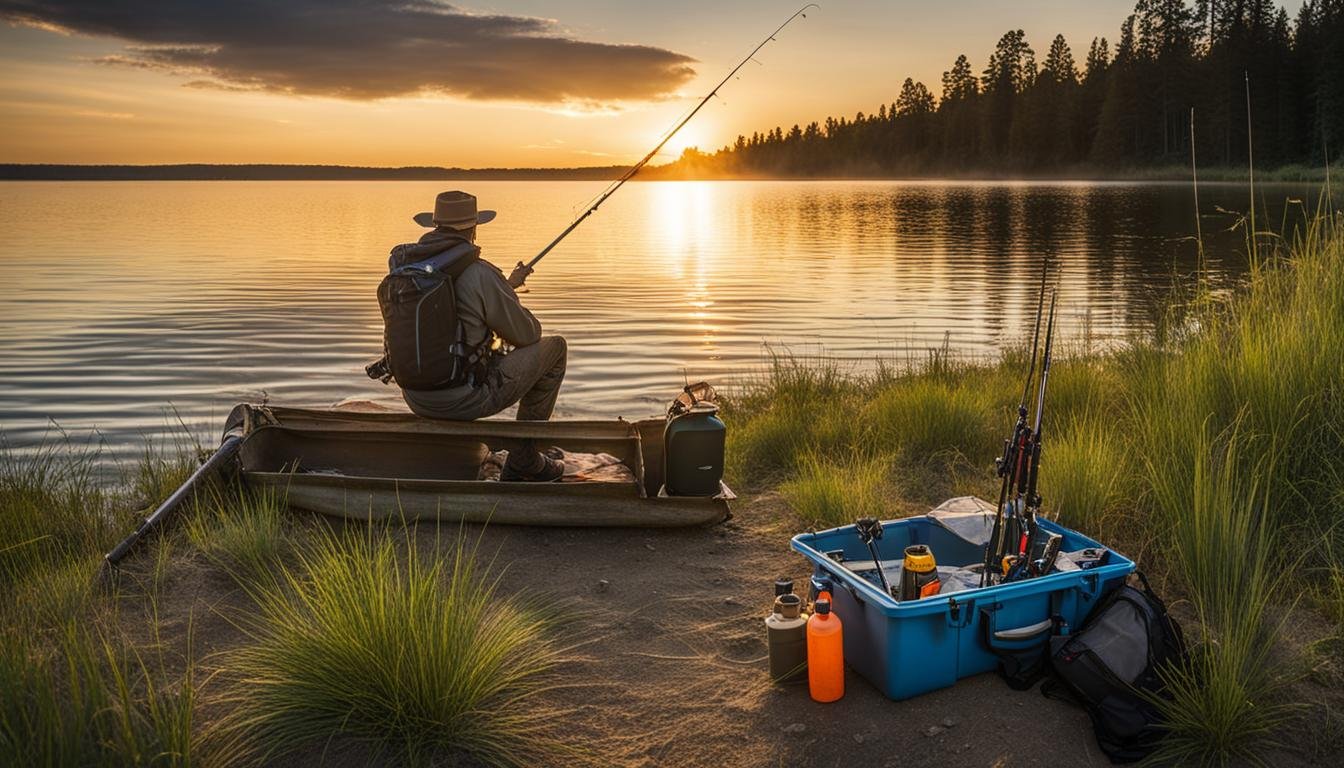No matter how experienced or inexperienced you are, fishing safety should always be a top priority. By following the right guidelines and rules, you can ensure a secure and enjoyable experience on your angling adventures. In this article, we will explore essential fishing safety guidelines that every beginner should know. These guidelines will help you minimize risks, avoid accidents, and make the most out of your fishing trips.
Before you cast your line, it’s crucial to understand the importance of fishing safety. Whether you’re heading out to a local lake or venturing into deeper waters, being prepared and aware of potential risks is key to enjoying your fishing experience to the fullest. From being knowledgeable about your surroundings to using proper safety equipment, we’ll cover all the essential tips and guidelines you need to know.

Be Aware of Your Surroundings
When it comes to fishing safety, being aware of your surroundings is crucial. Every fishing environment, whether it’s a river, lake, or the ocean, presents its own unique risks and hazards. Familiarizing yourself with the surroundings allows you to identify potential dangers and take necessary precautions to minimize the risks.
Understanding the water conditions is essential for safe fishing practices. Pay attention to currents, tides, and any sudden changes in weather that could affect the water conditions. This knowledge will help you make informed decisions and avoid potential accidents.
Identifying underwater obstructions is another important aspect of fishing safety. Rocks, logs, or other submerged objects can pose a threat to both you and your fishing gear. By being aware of these hazards, you can navigate your fishing spot safely and avoid damaging your equipment.
Additionally, it’s crucial to be mindful of any nearby boats or swimmers. Stay away from crowded areas and give other anglers and water enthusiasts enough space. This not only ensures your safety but also promotes a respectful and enjoyable fishing experience for everyone.
Use Proper Fishing Safety Equipment
Using proper fishing safety equipment is crucial for ensuring your safety during fishing trips. To minimize the risk of accidents and injuries, it is essential to have the right gear and protective measures in place.
- Personal Flotation Device (PFD) or Life Jacket: When fishing from a boat, always wear a PFD or life jacket. These essential safety devices can keep you afloat in case of an accidental fall or immersion in water, providing an extra layer of security.
- First Aid Kit: It is important to have a first aid kit on hand to treat any minor injuries that may occur while fishing. Be prepared with bandages, antiseptic ointment, pain relievers, and other necessary supplies.
- Fishing Hat, Sunglasses, and Sunscreen: Protect yourself from the elements by wearing a fishing hat to shield your face and head from the sun. Sunglasses with UV protection can safeguard your eyes from harmful rays, while sunscreen prevents sunburn and potential long-term skin damage.
- Insect Repellent: No one wants to be bothered by pesky insects while enjoying a fishing trip. Apply insect repellent to ward off bugs and keep yourself comfortable throughout the day.
Follow Safe Fishing Practices
When it comes to fishing, following safe practices is essential to ensure your safety and protect the environment. By practicing responsible fishing techniques, you can minimize risks and contribute to the preservation of fish populations. Here are some important fishing safety tips and practices to keep in mind:
- Handle fish with care: When catching and releasing fish, it’s crucial to handle them properly to minimize harm. Wet your hands before touching the fish to avoid removing their protective slime layer. Support the fish gently and avoid squeezing or dropping them. Always release the fish back into the water as quickly and gently as possible, allowing them to swim away on their own.
- Be aware of fishing regulations: Before heading out to fish, make sure you are aware of and comply with local fishing regulations. Educate yourself about catch limits, size restrictions, and any other specific rules or regulations that apply to the area where you’ll be fishing. Respecting these regulations helps safeguard fish populations and ensures the sustainability of the sport.
- Obtain necessary permits and licenses: In order to legally fish in certain areas, you may need to obtain permits or licenses. Check with local fishing authorities to determine what permits or licenses are required and make sure you have them before you start fishing. This not only keeps you on the right side of the law but also supports conservation efforts.
- Practice catch and release: While keeping a few fish for a meal is part of the fishing experience, it’s important to practice catch and release to maintain healthy fish populations. By releasing smaller or unwanted fish, you give them the chance to grow and reproduce, ensuring the sustainability of the fishery. Follow proper catch and release techniques to give the fish the best chance of survival.
- Conserve the environment: As anglers, it is our responsibility to protect the environment we fish in. Avoid littering and dispose of fishing line, hooks, and other trash properly to prevent it from harming wildlife. Respect sensitive habitats and avoid disturbing nesting or spawning areas. By leaving the environment as you found it, you contribute to the preservation of natural resources.
Stay Updated on Fishing Safety Guidelines

Fishing safety guidelines are essential for a safe and enjoyable fishing experience. However, these guidelines can vary depending on your location, the type of fishing you’re doing, and local regulations. To ensure that you’re following the most up-to-date fishing safety guidelines, it’s important to stay informed about the specific guidelines relevant to your area.
One way to stay updated on fishing safety knowledge is by reaching out to local fishing authorities. They can provide you with information on fishing seasons, restricted areas, and any recent changes in fishing regulations. Additionally, fishing guidebooks and online resources can provide valuable tips and advice on fishing safety.
To illustrate the importance of staying informed, imagine you’re planning a fishing trip to a lake that you’ve never been to before. By checking the fishing safety guidelines for that lake, you might discover that there are certain areas where fishing is prohibited due to environmental conservation efforts. By adhering to these guidelines, you not only avoid legal issues but also contribute to the preservation of fish populations.
By staying updated on fishing safety guidelines, you can ensure that you’re aware of any specific precautions or regulations that you should follow. This knowledge helps prevent accidental harm to yourself, others, and the environment. So, make it a habit to regularly check for updates in fishing safety guidelines and incorporate them into your fishing routine.
Be Prepared for Emergencies
When it comes to fishing safety, being prepared for emergencies is crucial. Before embarking on your fishing trip, make sure to check the weather forecast. Stay aware of any potential weather hazards such as storms or strong currents that could pose risks while you’re out on the water.
It’s also important to let someone know about your fishing plans. Share details such as your expected return time and the location where you’ll be fishing. In the event of an emergency, this information will help rescuers locate you quickly.
Carrying a fully charged mobile phone or a marine radio onboard is essential. These devices can be your lifeline in case of any emergencies, allowing you to call for help if needed.
Furthermore, having basic knowledge of first aid and CPR can be invaluable. Accidents and injuries can happen, especially when handling fishing equipment or navigating slippery surfaces. Being equipped with first aid skills will enable you to provide immediate care during critical moments until professional help arrives.
By being prepared for emergencies, you can ensure a safer fishing experience and tackle unexpected situations with confidence.
Practice Proper Fishing Techniques

When it comes to fishing, practicing proper techniques is crucial for both safety and success. By using the right fishing equipment and handling your tackle properly, you can minimize the risk of accidents and ensure a safe and enjoyable fishing experience.
When casting your line, always be mindful of your surroundings. It’s important to cast away from other people or boats to avoid entanglement or injury. Additionally, be cautious of sharp hooks and avoid casting towards anyone. By practicing proper casting techniques, you can prevent accidents and maintain a safe fishing environment.
Another important aspect of safe fishing practices is handling your fishing tackle appropriately. Make sure to securely hold your fishing rod, keeping a firm grip throughout the entire process. When reeling in a fish, use smooth and controlled movements to prevent the line from tangling or snapping. By practicing proper tackle handling techniques, you can avoid mishaps and ensure a successful fishing trip.
Stay Hydrated and Protected from the Sun
When you’re out fishing, it’s important to take care of your body and protect yourself from the elements. Fishing can be physically demanding, especially on hot and sunny days, so staying hydrated is crucial for your overall well-being and safety.
Make sure to drink plenty of water throughout your fishing trip to avoid dehydration and heat-related illnesses. Bring a water bottle with you or keep a cooler stocked with drinks to quench your thirst. Hydration is key to maintaining your energy levels and preventing fatigue.
In addition to staying hydrated, it’s essential to protect yourself from the sun’s harmful rays. Wearing sunscreen with a high SPF, a hat, and lightweight, breathable clothing will shield your skin from sunburns and reduce the risk of heatstroke. Investing in a quality pair of sunglasses will not only protect your eyes from the sun but also enhance your visibility while on the water.
Remember, even on cloudy days, the sun’s UV rays can still penetrate your skin, so don’t forget to apply sunscreen and wear protective clothing. By taking these simple yet important precautions, you can ensure a comfortable and safe fishing experience while protecting your skin and health.
Trust Your Instincts and Stay Safe
When it comes to fishing safety, trusting your instincts can make a significant difference in preventing potential accidents and ensuring a pleasant experience. If a situation feels unsafe or unfamiliar, it’s crucial to listen to your instincts and take necessary precautions to protect yourself and those around you.
Avoid taking unnecessary risks or engaging in dangerous activities while fishing. Sometimes, it can be tempting to push boundaries, but it’s important to prioritize your personal safety above all. By exercising caution and being mindful of potential hazards, you can minimize the chances of accidents and injuries.
Remember, safety should always be your top priority. Take the necessary fishing safety precautions and follow the guidelines we’ve discussed in this article. By doing so, you can enjoy fishing to the fullest while ensuring a secure and memorable experience for everyone involved. Happy fishing!
Looking For More Bass Fishing Content?
Check out our other bass fishing content to learn more about bass fishing
